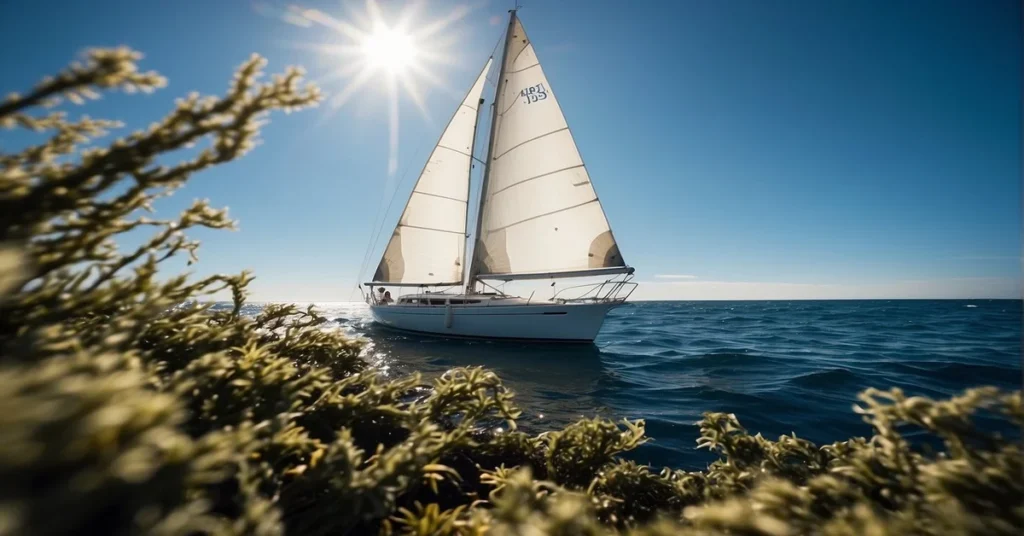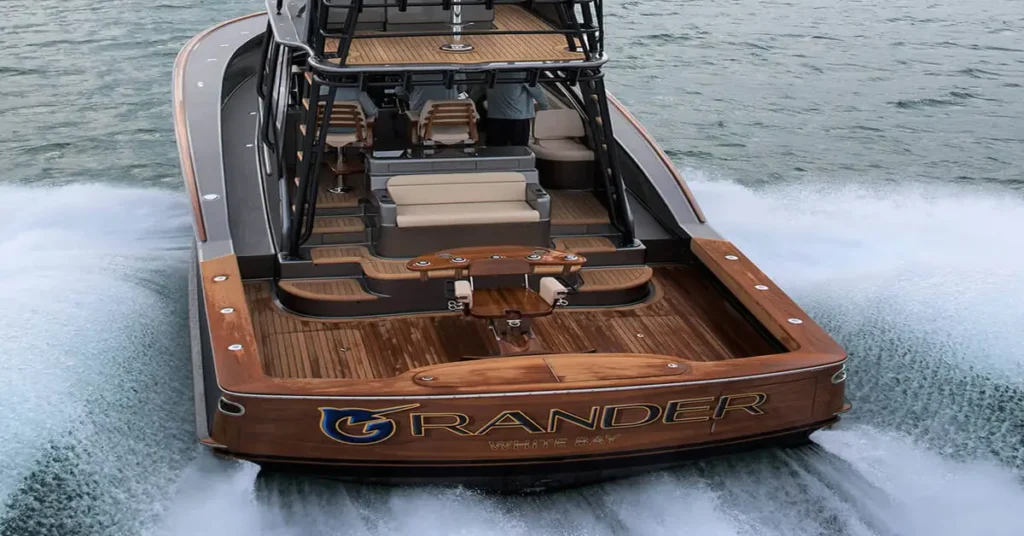Embark on a journey through the world of a Sailing Boat with Two Masts, where elegance meets efficiency on the open sea. These dual-masted marvels, encompassing ketches, yawls, and schooners, offer a distinctive sailing experience with enhanced sail configuration options.
Harness the wind with finesse and discover the thrill of mastering these classic vessels. This definitive guide for 2025 will steer you through the art of two-masted sailing, ensuring you capture both the performance advantages and the timeless beauty they bring to every voyage.
I’ve mastered the two-masted sail, and now, I’ll guide you to do the same
My Top 3 Two-masted sailing boat types
I’m always charmed by their aesthetics and functionality regarding a sailing boat with Two Masts. These boats strike a balance between the romance of traditional sailing and the demands of modern sailing. Here are my top three picks that exemplify the best in two-masted designs:
- Ketch
- Main Feature: The ketch has a larger mainmast followed by a smaller mizzen mast.
- Advantages: This design offers great balance and a variety of sail combinations, making it a good choice for those looking to cruise long distances with comfort.
- Yawl
- Main Feature: The yawl’s mizzen mast is placed behind the rudder post, similar to the ketch’s.
- Advantages: While it has less sail area than a ketch, the yawl offers better handling for windward performance and is adept at self-steering due to its mizzen sail.
- Schooner
- Main Feature: Schooners have two or more masts with the forward-most mast being shorter or the same height as the rear masts.
- Advantages: Famed for their speed and elegance, schoner’s multiple sails allow for a flexible sail plan that can be adjusted for different wind conditions.
- Each of these two-masted sailing boats offers a unique experience on the water, catering to sailors with various skills and preferences. Whether you prefer the steady comportment of a ketch, the maneuverability of a yawl, or the swift grace of a schooner, a Sailing Boat with Two Masts meets your sailing dreams.
Fundamentals of Two-Masted Sailboats

When I’m out at sea, I always see a sailing boat with two masts. These boats display a unique balance of tradition and performance, and their designs and functions are worth exploring.
Different Types of Two-Masted Sailboats
A Sailing Boat with Two Masts comes in several distinct types, each with a configuration suitable for various sailing needs. The yawl and ketch are commonly known; the yawl has its mizzenmast positioned aft of the steering post, which helps with balance and maneuverability.
On the other hand, the ketch has its mizzenmast forward of the rudder post, offering better sail distribution that aids in stability and ease of handling. The schooner, recognized for its elegant framework, typically features two (or more) masts of nearly equal height, which is efficient for downwind sailing.
These are not to be confused with a brig or brigantine, both of which are two-masted vessels but are fully square-rigged and square-and-fore-and-aft rigged, respectively, found more historically than in modern recreational sailing.
Basic Mast Configurations and Rig Types
The mast configuration and rig type significantly influence the performance of a Sailing Boat with Two Masts. The most common rig types are the Bermuda rig, gaff rig, and marconi rig. The renowned Bermuda rig—with triangular sails—is typically seen on modern sloops and cutters, known for efficiency and ease of use.
The gaff rig sports a four-sided mainsail with a spar at the top, adding a touch of tradition and aesthetic appeal. The Marconi rig, characterized by its taller masts and sleeker sail profile, is another popular choice. It is often associated with sloop rigs and delivers good speed and control.
With each rig type, the arrangement of sails between the foremast and mainmast, such as in ketch or cutter rig setups, will dictate how a two-masted sailing boat performs under various wind conditions.
Sails and Rigging Essentials

When it comes to a sailing boat with two masts, understanding the nuances of sails and rigging is crucial for smooth sailing and optimal performance. I’ll guide you through the core components of the sails and rigs, specifically the main sails and headsails, and the intricacies of sail shapes and types.
Main Sails and Headsails
The main sail of a Sailing Boat with Two Masts is typically the largest sail, affixed to the mainmast and playing a vital role in harnessing the wind’s power. In contrast, the headsails, which include jibs, staysails, and sometimes spinnakers, are attached to the foremast and have their own specific functions.
Jibs are triangular sails that set forward of the mast, while staysails are found between masts on ketches or schooners. The spinnaker, a large, often colorful sail, is used for downwind sailing and can be quite powerful in boosting the boat’s speed.
- Main sails: Mainsail, Mizzen
- Headsails: Jib, Staysail, Spinnaker
Understanding Sail Shapes and Types
The shape and type of sail are pivotal in determining a boat’s handling and efficiency. Fore-and-aft rigged sails, which are more common in modern sailing boats, are generally triangular and allow for better windward performance. Square-rigged sails, which you see on tall ships, are set across the ship and are great for downwind travel.
- Fore-and-aft rigged sails: Bermuda sloop, Gaff-rigged
- Triangular sails: Jib, Spinnaker
- Square-rigged sails: Topsail, Foresail
Different sail combinations can be deployed in a two-masted setup depending on the conditions and desired handling characteristics. A ketch, for example, will have a mizzen sail that’s smaller than the mainsail and is handy for balancing the boat. Sail shape also plays a role; it’s not just about the type. The cut and trim of a sail determine how efficiently it captures the wind, and here, the art of sailing really comes to the fore.
Each sail type from the main sails and headsails to the complex sail shapes must be understood to effectively handle my sailing vessel. Whether I’m adjusting the mainsail for a broad reach or tweaking the jib to cut closer to the wind, knowledge of these essentials makes the journey that much smoother.
Performance and Maneuverability

When I’m at the helm of a sailing boat with two masts, I can’t help but notice how the design influences the vessel’s speed and stability, offering unique handling capabilities, especially in heavy weather conditions.
Speed and Stability on Water
A sailing boat with two masts often provides a remarkable balance between speed and stability on the water. These vessels, which can be trimarans, catamarans, or monohulls, use their sail configuration to optimize performance. Proper sail balance can enhance upwind performance, ensuring that the boat harnesses wind power efficiently.
On the other hand, downwind performance tends to be impressive, as the additional sails can harness more wind over larger surface areas.
Handling Techniques and Heavy Weather Sailing
Understanding the handling techniques for a two-masted sailing boat can significantly affect maneuverability and safety. In heavy weather, options like reducing sail area or changing the rigging setup become critical. Adjusting the sails, such as reefing the mainsail or mizzen, contributes to maintaining sail balance and stability. Moreover, experienced sailors rely on specific rigging adjustments for enhanced performance, customizing the vessel’s response to the sea’s demands.
Additional Considerations for Sailors

When you’re exploring the idea of a sailing boat with two masts, several factors specifically tailor to the complexity and uniqueness of these vessels. It’s paramount to focus on aspects that ensure both comfort and safety, as well as dedicated maintenance routines.
Comfort and Safety Onboard
Cruising on a vessel like a ketch or a yawl, which are popular types of sailboats with two masts, requires attention to comfort and safety for all aboard. The cockpit should be designed for easy movement and provide protection from the elements, often involving a sturdy canvas cover. In addition to the living spaces, features like a reliable rudder post and a sturdy hull contribute to a safe journey. Boom placement is also crucial to prevent accidents on deck.
Below the deck, the sleeping quarters, galley, and navigation station should blend cosiness with functionality. It’s wise to choose a boat with a full keel or a fin keel, as they provide greater stability which can reduce the likelihood of a capsize. And don’t forget, the right sail rig types and mast configurations can greatly impact the vessel’s balance and seakeeping abilities.
Maintenance and Care for Two-Masted Vessels
Maintaining a two-masted sailboat is a significant responsibility that should not be taken lightly. Regular upkeep of the masts, including the bowsprit if present, is essential to ensure they are structurally sound. The fiberglass or wooden components of the boat may demand different treatments and checks for integrity. Regular reefing practice is important, as it reduces sail area in high winds, placing less strain on the masts and rigging.
Moreover, attention must be paid to the keels, whose condition is critical for your boat’s performance and safety. Whether you use your boat for leisure, such as fishing, or more competitive pursuits, consistent care is the key to longevity and enjoyment of your sailing experience.
FAQ – Sailing Boat with Two Masts

When I first encountered a sailing boat with two masts, I was intrigued by its unique rigging and its versatility. It’s fascinating how these setups impact sailing performance and aesthetics.
What do you call a sailboat with 2 masts?
What sailing vessels have two masts?
Several types of sailing vessels boast two masts. These include the ketch, the yawl, the schooner, and occasionally a variant called a lugger. Each type has its special features that suit different sailing needs, whether it’s for cruising, racing, or traditional appeal.
What are two masts of the same height?
A sailing boat with two masts of the same height is known as a schooner. Schooners can also have additional masts, and their sail configuration really sets them apart, with the forward-most mast being slightly shorter or the same height as the other mast(s).
This rigging is designed to improve windward ability and is often associated with classic sailing vessels used for various purposes, from fishing to leisure.
Set sail on the discussion sea: Share your two-masted tales and tips in the comments below!



